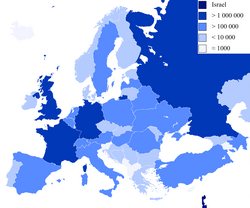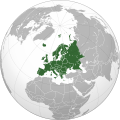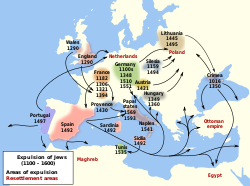History of the Jews in Europe
Jews have lived in Europe for thousands of years, and their dispersal and relations with governing authorities and peoples have changed greatly. In the Roman Republic and Roman Empire, there was a Jewish minority which had varying rights and relations with the Romans.[1] After the Roman-Jewish wars in the first and second centuries and the destruction of the Temple, Jews were expelled from Judea, which greatly increased their numbers in Europe (and North Africa and Asia). In the Middle Ages, with the spread of Christianity and Christian anti-Semitism, conditions were generally bad. Jews were often separated from Christians. They were not allowed in some jobs . They were made to live in particular parts of cities, called ghettos. They were allowed to do certain jobs that Christians were not allowed to, such as lending money to people for interest, which was considered bad for Christians. This made some Jews wealthy but also increased persecutions.[2]

Jews were eventually welcomed in Poland, whose king declared the Statute of Kalisz to protect them.[3] Ashkenazi Jews lived in Eastern Europe. Sephardi Jews lived In Spain and Portugal. Under Muslim rule, the so-called Al Andalus period,[4] Jews were generally accepted although they could not take part in the government. After Christian rule was re-established on the Iberian peninsula, Jews were rejected and persecuted if they stayed. Some sought refuge in the Ottoman Empire, which was then relatively tolerant to Jews and Christians and allowed them to have their own courts and laws, as long as they payed taxes and did not resist Ottoman rule.[5]

After the Renaissance and the Early Modern Period, Jews were integrated increasingly and permitted to live openly as Jews in more and more countries. After the French Revolution, France and other European countries affected by French rule through Napoleon I introduced secular laws aimed at abolishing religion in the public sphere and treating Jews more openly as citizens.[6] Jews began to discard their religion by becoming Christians, like British Prime Minister Benjamin Disraeli's father, Isaac d'Israeli. Many European countries had restrictions on Jews until the 19th and 20th centuries such as banning them from certain professions or holding public offices. Many Jews became prominent scientists or public intellectuals such as Karl Marx, Sigmund Freud and Albert Einstein.
Some emigrated to the United States and other American countries,[7] including Argentina, which to this day has a large Jewish community.[8] Eventually, the United States gathered the largest Jewish population outside of the Russian Empire. After Poland became an independent country again after the Treaty of Versailles, it had the largest Jewish population in Europe, with about 3,000,000 Jews. The Soviet Union, which came about in 1922, had nearly as many. With Adolf Hitler's rise to power in Germany, there was again increased emigration, to the Western European countries and to the United States, supported by the Germans who did not want Jews in German-governed territory. More Jews emigrated to Palestine, which had been taken from the Ottoman Turks by the United Kingdom in 1917, to establish a Jewish homeland for Jews. Hitler temporarily supported this migration, but the British were sceptic, as the greater number of Jews meant conflicts with the local Arabs, who resisted Jewish immigration, and several bloody rebellions were fought between them and the British troops in the region. With World War II, the Nazi-controlled German armies occupied most of Europe and started to deport Jews east, eventually adopting a policy of mass murder known as the Holocaust.[9] After 1942, all Jews under German control (with very few exceptions) would be sent to Eastern Europe and killed or worked to death. In the end, before Nazi Germany's defeat in 1945, this killed about two thirds of the Jewish population in Europe. Only the Jewish communities of Albania, Denmark, Sweden, Switzerland, Spain, Portugal, Britain and Ireland were untouched, and those of Italy, Yugoslavia and Romania much less affected. Many remaining Jews migrated to the United States and Palestine, where Israel was created in 1948 as a Jewish-majority state, which resulted in Europe losing most of its Jewish population and the United States becoming the most Jewish country.[10] Later persecution in Communist Poland and other countries led to more refugees. In Poland less than 3,000 remain today. In France, the United Kingdom and Russia, however, there are significant communities left comparable to before the war.
History Of The Jews In Europe Media
The location of modern-day Europe (dark green)
Sultan Bayezid II sent Kemal Reis to save the Arabs and Sephardic Jews of Spain from the Spanish Inquisition in 1492, and granted them permission to settle in the Ottoman Empire
Interior of the Portuguese Synagogue, Amsterdam in 1695 by Romeyn de Hooghe
Late renaissance synagogue in Zamość, Poland (1610–1620)
References
- ↑ "History of The Jews in The Roman Empire". The Spiritual Life. 2020-03-25. Retrieved 2021-05-19.
- ↑ "History & Overview of Christian-Jewish Relations". www.jewishvirtuallibrary.org. Retrieved 2021-05-19.
- ↑ "Jewish Life in Poland Before the Holocaust". Facing History and Ourselves. Retrieved 2021-05-19.
- ↑ "The Golden Age of Jews in Sepharad/Al-Andalus genealogy project". geni_family_tree. Retrieved 2021-05-19.
- ↑ "The Sephardic Exodus to the Ottoman Empire". My Jewish Learning. Retrieved 2021-05-19.
- ↑ Berkovitz, Jay R. (April 1995). "The French Revolution and the Jews: Assessing the Cultural Impact". AJS Review. 20 (1): 25–86. doi:10.1017/S0364009400006309. ISSN 1475-4541. S2CID 162609380.
- ↑ "A History of Jews in the United States". Reform Judaism. Retrieved 2021-05-19.
- ↑ "Jewish Immigration to Argentina | Modern Latin America". library.brown.edu. Retrieved 2021-05-19.
- ↑ "German Jews during the Holocaust, 1939–1945". encyclopedia.ushmm.org. Retrieved 2021-05-19.
- ↑ "Jewish Claim To The Land Of Israel". www.jewishvirtuallibrary.org. Retrieved 2021-05-19.










